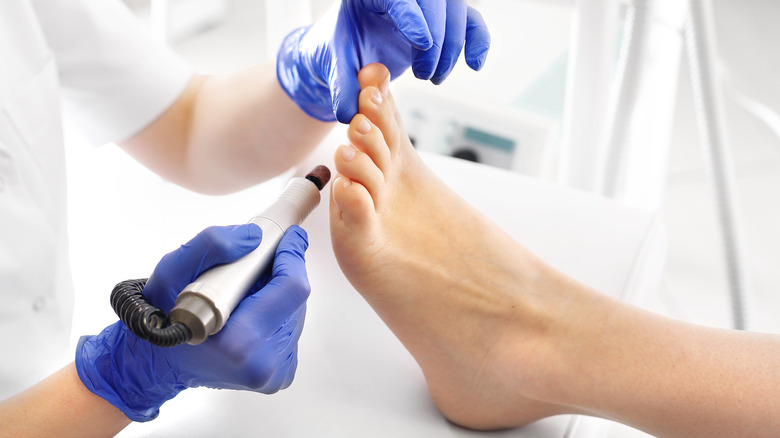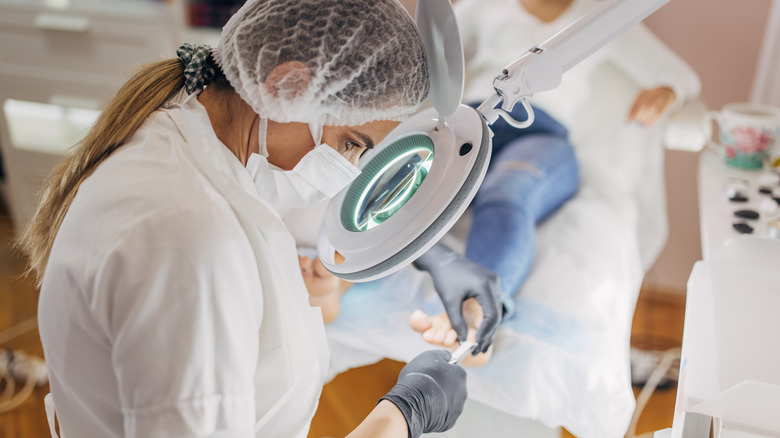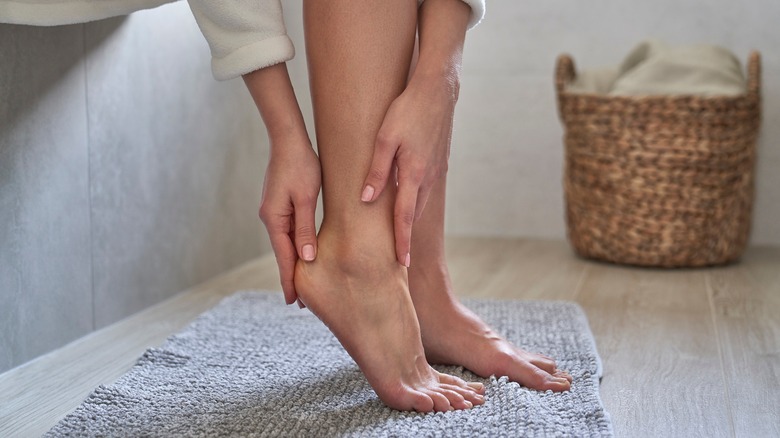How A Medical Pedicure Can Get Your Feet Sandal Season Ready
We'll just go right ahead and say it: The feet aren't the sexiest parts of the human body. Many of us also treat them as an afterthought, too, when they are quite literally the very things that bear our weight and take us from point A to point B. Our precious feet always have to endure so much, and all they get in return is getting shoved into sneakers or squeezed into impossibly tight stilettos. Do you know how powerful your feet are? Hear this: "Over a lifetime, the average person circumnavigates the Earth's circumference more than five times," Adam D. Perler, a podiatrist, told Runner's World. "There are very few complex mechanical things we can engineer that would be able to withstand so many cycles without complete failure or breakdown."
According to experts, we ought to take better care of our hoofs. Not only do they function as the foundation of our bodies and bear the brunt of our daily activities, but their state is also indicative of our overall well-being. Podiatrist and podiatric surgeon Dr. Dana Canuso told Well+Good that "healthy feet and skin should appear well-hydrated and toenails should be pink-ish and flat." Going on routine pedicures can definitely help, but if you want to show your feet more love, you may want to look into getting medical pedicures instead. And yes, they exist.
A medical pedicure may sound like an excuse for podiatrists to overcharge for a standard procedure you can otherwise get at your favorite spa, but as it turns out, it works miracles on your foot health. It's also performed in a sterile environment rather than a cozy space with pastel-colored walls and plush couches. During a medical pedicure, the focus goes way beyond ensuring that your feet are sandal-ready.
Inside the benefits of a 'medi pedi'
"Medical pedicures are customized to what your feet need as opposed to just simple aesthetics. They're specific and very thorough, paying close attention to the health of your nails and skin not just how they 'look,'" Marcela Correa, a licensed medical pedicurist and owner of Medi Pedi, shared with InStyle. "A medical pedicure is also centered around prevention. Medical nail technicians performing the service have been trained under a podiatrist and can detect things like nail fungus, athlete's foot, calluses, and corns, as well as educate you on treating and preventing them at home."
Rather than painting your toes with pretty colors and slathering fancy lotion on your heels and ankles, a medical pedicure is tailored to your puppies' unique needs. Experts will do a thorough evaluation of your feet, and customize your pedicure accordingly. They'll tackle all sorts of foot-related concerns, including calluses, Athlete's foot, cracked heels, bunions, nail discoloration, ingrown nails, and more. In the procedure, every instrument used is medical-grade and sanitized, and no icky double-dipping is involved. "Also, this is a dry pedicure and there is no soaking of the feet, which eliminates any build-up of bacteria," podiatrist Dr. Rico Visperas told Today.
How else can I give my feet extra TLC?
With medical pedicures typically costing in the $200 range, they may not be accessible to everyone. Of course, it doesn't mean that there are no alternatives to keeping your feet pretty, healthy, and sandal-ready. If you want to improve your foot care, take matters into your own hands and do more than get your bi-weekly pedicures.
You can start by exfoliating your feet at home, which Crystal Richards, a spa manager, said could help slough off dead skin cells and remedy dryness and cracking. "Take a foot file and pumice stone to remove the dry, calloused skin from the bottoms of your feet," she advised StyleCaster. Keeping them moisturized also does wonders, so make sure that you coat them in hydrating oil or lotion before you hit the sack. Just be sure that they're formulated specifically for use on feet. "Soles also have an extra layer of skin that is nowhere else on the body," manicurist Erin Beckett-Gland explained to HuffPost. "Choose products that have a molecular structure small enough to penetrate the sole of the foot skin."
And for the love that is good and holy, wear better shoes. The occasional naked shoes or four-inch sandals are fine now and then, but your feet need better homes. "Ill-fitting shoes can cause overuse injuries as they affect the shock-absorbing capability of the foot and abnormally compress the muscles, tendons, and ligaments, leading to inflammation and swelling," Dr. Rock Positano, director of the Non-Surgical Foot and Ankle Service at The Hospital for Special Surgery and New York-Presbyterian Hospital/Weill Cornell, told Runner's World. At the very least, pick a pair that has enough cushion to spare your feet from daily wear and tear.


